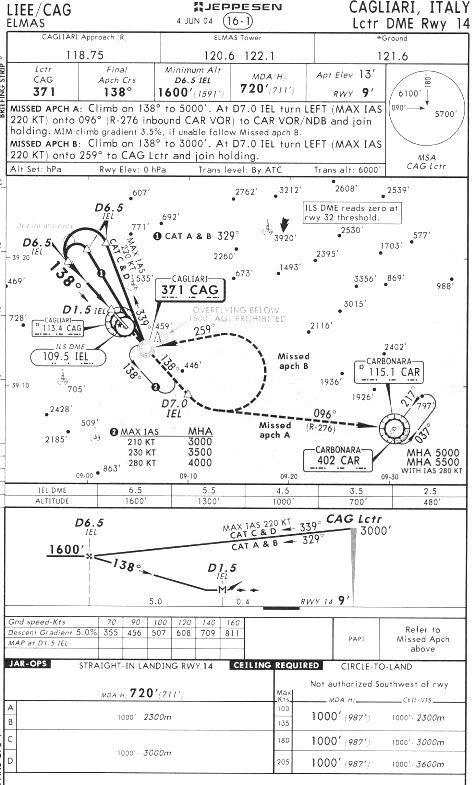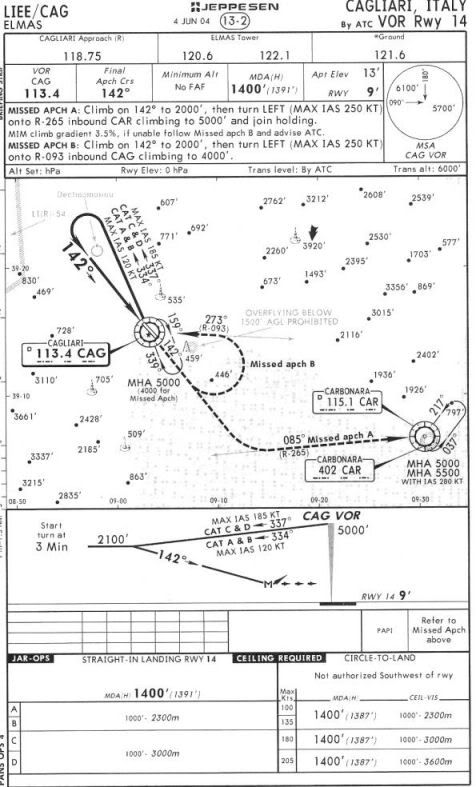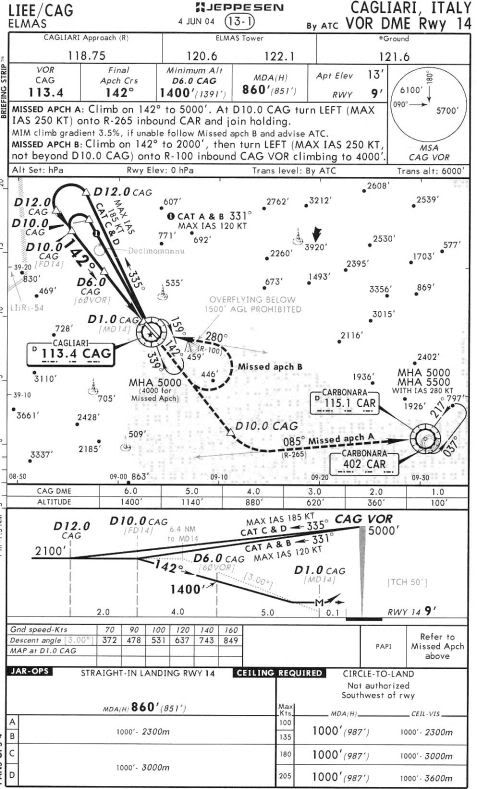Final Approach Fix (FAF)
Thread Starter
Join Date: May 2001
Location: Italy
Posts: 61
Likes: 0
Received 0 Likes
on
0 Posts
Can someone tell me why some non-precision approach procedures (VOR/VORDME NDB) show the Maltese cross as FAF in the profile view and some other non-precision apps don't do that? 
As an example look at the LIML/LIN VORDME18L (with FAF) and LIML/LIN VORDME36R (no FAF:no Maltese cross)
What's the criteria to show or not to show the FAF on a non-precision approach profile view?
thanks
B_D

As an example look at the LIML/LIN VORDME18L (with FAF) and LIML/LIN VORDME36R (no FAF:no Maltese cross)
What's the criteria to show or not to show the FAF on a non-precision approach profile view?
thanks
B_D
Join Date: Aug 2001
Location: Poughkeepsie
Posts: 236
Likes: 0
Received 0 Likes
on
0 Posts
The charts I'm looking at are both dated 24/02/2006.
36R, you are correct there's no FAF, fair point, I'm not too sure why. However in the footnote 'Changes' it says "Fix withdrawn".
The deal with 18L, is the FAF I believe has been added.
I can't answer the initial question, maybe misprint? However the VOR shoud suffice for the FAF even though it is not marked on the chart with standard cross.
IR
36R, you are correct there's no FAF, fair point, I'm not too sure why. However in the footnote 'Changes' it says "Fix withdrawn".
The deal with 18L, is the FAF I believe has been added.
I can't answer the initial question, maybe misprint? However the VOR shoud suffice for the FAF even though it is not marked on the chart with standard cross.
IR
Join Date: Aug 2005
Location: Apparently canada
Posts: 140
Likes: 0
Received 0 Likes
on
0 Posts
Minimum obstacle clearance (MOC)
for the final segment
Fixed margin for all aircraft
90 m (235') without FAF
75 m (246')with FAF
(FAF -final approach fix)
Relationship of obstacle clearance altitude/height (OCA/H) to minimum descent altitude/height
(MDA/H) for non-precision approaches (example with a controlling obstacle in the final approach)
In the absence of a FAF. descent to MDA/H is made once the aircraft is established inbound on the final approach track. Procedure altitudes/heights will not be developed for non-precision approach procedures without a FAF.
In procedures of this type, the final approach track cannot normally be aligned on the runway centre line.
Whether OCA/H for straight-in approach limits are published or not depends on the angular difference between the track and the runway and position of the track with respect to the runway threshold.
Hope this helps
for the final segment
Fixed margin for all aircraft
90 m (235') without FAF
75 m (246')with FAF
(FAF -final approach fix)
Relationship of obstacle clearance altitude/height (OCA/H) to minimum descent altitude/height
(MDA/H) for non-precision approaches (example with a controlling obstacle in the final approach)
In the absence of a FAF. descent to MDA/H is made once the aircraft is established inbound on the final approach track. Procedure altitudes/heights will not be developed for non-precision approach procedures without a FAF.
In procedures of this type, the final approach track cannot normally be aligned on the runway centre line.
Whether OCA/H for straight-in approach limits are published or not depends on the angular difference between the track and the runway and position of the track with respect to the runway threshold.
Hope this helps

PPRuNeaholic
Join Date: Jun 2000
Location: Cairns FNQ
Posts: 3,255
Likes: 0
Received 0 Likes
on
0 Posts
Yes, PRNAV1 has given you the answer - although 90 metres equates to 295 feet and, under Pans Ops the actual value is 294 feet which is rounded to 90 metres for the equivalent SI value. Thus, for reasons best known to the procedure designer, obstacle clearance in the final segment is 294 (or 295) feet.
Just as a matter of professional interest, can you tell me how far away from the THR was the FAF in the previous procedure? That might help me to explain why it was withdrawn.
Just as a matter of professional interest, can you tell me how far away from the THR was the FAF in the previous procedure? That might help me to explain why it was withdrawn.
Thread Starter
Join Date: May 2001
Location: Italy
Posts: 61
Likes: 0
Received 0 Likes
on
0 Posts
OzExpat
i can't remember the distance
If you can look at some Frankfurt non-precision app you'll see they put the FAF (cross) at 12nm. (rulebook states to put the FAF around 5nm!).Maybe the distance is not a factor
Another good example is LIEE/CAG VOR,VORDME 14, no FAF, but Lctr DME 14
has the FAF (cross).
My question is: why, along the same rwy, do we have a Locator DME proc. with a final fix and a VORDME app without it (no cross)?
B_D
i can't remember the distance

If you can look at some Frankfurt non-precision app you'll see they put the FAF (cross) at 12nm. (rulebook states to put the FAF around 5nm!).Maybe the distance is not a factor

Another good example is LIEE/CAG VOR,VORDME 14, no FAF, but Lctr DME 14
has the FAF (cross).
My question is: why, along the same rwy, do we have a Locator DME proc. with a final fix and a VORDME app without it (no cross)?
B_D
Guest
Posts: n/a
Something similar cropped up in my IR sim session today. There are non-precision approachs which permit both DME and non-DME approaches. For such approaches, in the case where the FAF is defined as a distance and not a time from the DME and the DME is not available (for whatever reason) then, once base is complete and within +/- 5deg of the inbound QDM you may begin the descent.
PPRuNeaholic
Join Date: Jun 2000
Location: Cairns FNQ
Posts: 3,255
Likes: 0
Received 0 Likes
on
0 Posts
(rulebook states to put the FAF around 5nm!)
My internet connection isn't fast enough or cheap enough to allow me to surf the web for any approach procedures but if you look at them in relation to distance from the THR, this might provide a clue. There is just one other possibility, however, which has just occurred to me as a result of your statement :-
Another good example is LIEE/CAG VOR,VORDME 14, no FAF, but Lctr DME 14 has the FAF (cross).
Or maybe it's for ATC traffic management, or lateral separation, purposes. They need to provide broader separation for aircraft tracking by reference to a NDB because it's less accurate than a VOR.
As you can see, it's a bit difficult to provide any substantive comment without an evaluation of the actual procedures. However, as long as you abide by the specifications on the approach chart, it won't actually matter whether there's a FAF or not.
Thread Starter
Join Date: May 2001
Location: Italy
Posts: 61
Likes: 0
Received 0 Likes
on
0 Posts
OzExpat and the others
thanks for your help
i've scanned the procedure plates for LIEE, but i don't know how to upload them: the insert immage command ask me for a url, but the images are on my computer's harddisk.
any help?
B_D
thanks for your help
i've scanned the procedure plates for LIEE, but i don't know how to upload them: the insert immage command ask me for a url, but the images are on my computer's harddisk.
any help?
B_D
Join Date: Aug 2001
Location: Europe
Posts: 117
Likes: 0
Received 0 Likes
on
0 Posts
Hi B_D,
you need to upload the pic onto an "Image host" server. You'll get an url there which you can link.
There are lots of free sites available, google might help. You may have to downsize the image though (most servers have a max size limit).
you need to upload the pic onto an "Image host" server. You'll get an url there which you can link.
There are lots of free sites available, google might help. You may have to downsize the image though (most servers have a max size limit).
PPRuNeaholic
Join Date: Jun 2000
Location: Cairns FNQ
Posts: 3,255
Likes: 0
Received 0 Likes
on
0 Posts
Black_Dawn... If you're going to upload them to a site, as suggested by dolly737, please downsize them as I can't download large images. This action will also speed your upload.
PPRuNeaholic
Join Date: Jun 2000
Location: Cairns FNQ
Posts: 3,255
Likes: 0
Received 0 Likes
on
0 Posts
There's no reason that I can put my finger on as to why the LCTR/DME needs a FAF or why the VOR/DME procedure does not need it. The VOR procedure can't use one because there's no way to identify the fix.
The place is obviously difficult, with lots of obstacles in the vicinity, a Restricted area close by and some other sort of area that cannot be overflown below 1500 feet AGL. That's a useless note, by the way, because there's no indication of the elevation of ground level in that area.
I note that in both the LCTR/DME and VOR/DME procedures, the commencement of final segment of the procedure is markedly different (6.5 and 12.0 respectively). This is probably due to the larger protection area for the base turn in the NDB-based procedure, in relation to it's proximity to the Restricted Area. The protection area for the VOR-based base-turn would be somewhat smaller but I wouldn't have thought that it would make such a great difference (ie 5.5 NM), when the distance between the VOR and NDB doesn't seem to be more than about 3 NM.
Significantly, the 3-degree profile (shown on the VOR/DME chart) starts at 6.4 DME. This seems to be 6.3 NM from the THR, so the MOC on final must be at least 294 feet. The 6.5 DME position identified on the LCTR/DME chart seems to be 6.1 NM from the RWY so, once again, MOC must be at least 294 feet.
In each case, the position at which final approach is commenced can be identified by the pilot without reference to DME (ie by being within the standard tracking tolerance for the final approach track). Thus, I wouldn't have thought that there was any need for a FAF on the LCTR/DME chart. So the best answer I can give you is... "beats the heck out of me!". Had I been designing these procedures, I feel sure that I wouldn't have included a FAF on the LCTR/DME chart.
The place is obviously difficult, with lots of obstacles in the vicinity, a Restricted area close by and some other sort of area that cannot be overflown below 1500 feet AGL. That's a useless note, by the way, because there's no indication of the elevation of ground level in that area.
I note that in both the LCTR/DME and VOR/DME procedures, the commencement of final segment of the procedure is markedly different (6.5 and 12.0 respectively). This is probably due to the larger protection area for the base turn in the NDB-based procedure, in relation to it's proximity to the Restricted Area. The protection area for the VOR-based base-turn would be somewhat smaller but I wouldn't have thought that it would make such a great difference (ie 5.5 NM), when the distance between the VOR and NDB doesn't seem to be more than about 3 NM.
Significantly, the 3-degree profile (shown on the VOR/DME chart) starts at 6.4 DME. This seems to be 6.3 NM from the THR, so the MOC on final must be at least 294 feet. The 6.5 DME position identified on the LCTR/DME chart seems to be 6.1 NM from the RWY so, once again, MOC must be at least 294 feet.
In each case, the position at which final approach is commenced can be identified by the pilot without reference to DME (ie by being within the standard tracking tolerance for the final approach track). Thus, I wouldn't have thought that there was any need for a FAF on the LCTR/DME chart. So the best answer I can give you is... "beats the heck out of me!". Had I been designing these procedures, I feel sure that I wouldn't have included a FAF on the LCTR/DME chart.
Thread Starter
Join Date: May 2001
Location: Italy
Posts: 61
Likes: 0
Received 0 Likes
on
0 Posts
OzExpat
thanks for your help
do you have any suggested reading or book, maybe a site, where i could get something about instrument procedures design?
again thanks
B_D
thanks for your help

do you have any suggested reading or book, maybe a site, where i could get something about instrument procedures design?
again thanks
B_D
Join Date: Mar 2006
Location: A oneworld lounge near you
Posts: 145
Likes: 0
Received 0 Likes
on
0 Posts
ICAO Doc 8168 V2 is the main reference book
For severe techie questions, try the owner of the www.asap.sk site if it is still in that area. He is a Kiwi and knows a lot.
However, there are several nasty errors on those plates. I will try to take a look at them later today. My record is finding 18 errors on a plate. Still, actually none of them were related to the reason that the aircraft hit the mountain!
For severe techie questions, try the owner of the www.asap.sk site if it is still in that area. He is a Kiwi and knows a lot.
However, there are several nasty errors on those plates. I will try to take a look at them later today. My record is finding 18 errors on a plate. Still, actually none of them were related to the reason that the aircraft hit the mountain!
PPRuNeaholic
Join Date: Jun 2000
Location: Cairns FNQ
Posts: 3,255
Likes: 0
Received 0 Likes
on
0 Posts
Black_Dawn... As stated by discountinvestigator, ICAO document 8168-OPS/611, Volume 2, is the only reference. It's pretty heavy reading and, without some training, will be very difficult for you to understand as it's a very highly technical document.
However, if you want to have a crack at it, think I read, in another thread somewhere on PPRuNe, that the Danes have a lot of ICAO publications online. I don't know if Pans Ops will be one of them, or whether it's completely up to date, but worth checking. Perhaps someone else can identify the thread, or the URL for the Danish website.
However, if you want to have a crack at it, think I read, in another thread somewhere on PPRuNe, that the Danes have a lot of ICAO publications online. I don't know if Pans Ops will be one of them, or whether it's completely up to date, but worth checking. Perhaps someone else can identify the thread, or the URL for the Danish website.
The answer may be simply that it is not depicted in the national AIP. At the end of the day, Jeppessen and Aerad do not design the approaches: they copy the National Procedures and present them in their own style.
Having operated in some of the less well regulated areas inthe world, I have seen some abysmal plates from respected companies, but they are hamstrung if the information is eroneous or incomplete: they can't add bits or fill in the gaps themselves.
Having operated in some of the less well regulated areas inthe world, I have seen some abysmal plates from respected companies, but they are hamstrung if the information is eroneous or incomplete: they can't add bits or fill in the gaps themselves.
Join Date: Mar 2006
Location: A oneworld lounge near you
Posts: 145
Likes: 0
Received 0 Likes
on
0 Posts
designing charts
I disagree with the previous post by 212 man. I have worked in several areas of the world where the jepps and aerads have had the navigation aids at the correct end of the runway whereas the national AIP has been incorrect.
In addition the commercial companies have published procedures for navigation aids not shown in the AIP.
I routinely work in countries where the AIP is between 2 and 15 years out of date. Of course, your company audit of the airport prior to starting flight operations will detect these issues and then appear on the Captain's brief. And for diversion airports as well. At least in theory....
In addition the commercial companies have published procedures for navigation aids not shown in the AIP.
I routinely work in countries where the AIP is between 2 and 15 years out of date. Of course, your company audit of the airport prior to starting flight operations will detect these issues and then appear on the Captain's brief. And for diversion airports as well. At least in theory....







